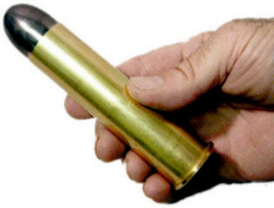

 The Accurate Reloading Forums
The Accurate Reloading Forums  THE ACCURATE RELOADING.COM FORUMS
THE ACCURATE RELOADING.COM FORUMS  Rifles
Rifles  Wildcats And Their Development
Wildcats And Their Development  Case Capacity
Case CapacityGo  | New  | Find  | Notify  | Tools  | Reply  |  |
| one of us |
I'm experimenting with 17 Mach IV loads. Most of the load data out there are based on the 221 Fireball case neck down to 17 caliber. I have been using 223 brass because it is higher quality and I have tons of it available. However, the average 223 brass holds about .4 grains less powder than the average 221 FB brass. Is there anyway to extrapolate bullet velocities and case pressure in the 223 case based on data gathered using 221 FB brass? I'm still going to begin with starting charge and work up, but I was looking for some estimates. Regards, Kory | ||
|
| one of us |
Kory A rule of thumb is to convert the difference in grains weight to a percentage. Velocity can be expected to increase or decrease by the same percentage but the pressure will increase or decrease by the square of the percentage. The same rule can be used when comparing bullets of different weight. Remember this is just a general rule of thumb and assumes there are no other changes made at the same time, such as different bullet, powder, or primer. Always err on the side of safety and reduce charges and work back up. | |||
|
| one of us |
Hi Cheechako, Thanks for the reply. I'm still a bit confused.  Let me use this example (and I'm just making up some numbers here): let say a 221 FB case has a max capacity of 20 grains. If I load it with 15 grains of H4198 with a Berger 25 grain bullet, I will get a velocity of 3600 FPS, with a pressure of 50,000 PSI. Now, how can I estimate the velocity and pressure using the exact same load, but in a 223 case which has a max capacity of 19.6 grains? Regards, Kory | |||
|
| one of us |
Kory Remember, this is just an estimate based on the general rule of thumb. The difference in case capacity is 2% (20.0/19.6). Not changing anything but the case, your velocity will increase by 2% from 3600 to 3670 but your pressure will increase by 4.1% (1.02 x 1.02) from 50,000 to 52,060. So you will gain only 70 fps at the expense of more than 2000 psi. Working the other way, to maintain the same pressure and velocity you should reduce your charge by 2% from 15 grains to 14.7. This is the principal that a ballistic calculator is based on but, as we know, they are not infallible because there are so many variables in barrels, primers, bullets, temperature, etc etc. That is why most ballistic programs and loading manuals will always give you less than max loads. Also, keep in mind that in the smaller cartridges such as yours, small differences are magnified. 1/2 grain of powder in a 30-06 may mean nothing but in a 222 sized case it could be critical. As I said, the best approach is to start low and work back up any time you change anything. The small cost of a few components is nothing compared to the cost of your rifle, or your fingers or eyes. | |||
|
| one of us |
Kory, This is a good use for internal ballistic program such as Quickload because the absolute accuracy, ie. single point simulation vs measured data, requires checkpoints whereas a relative calculation, ie comparing small changes, is usually quite good. I ran your scenario thru Quickload and it estimates a 0.8% increase in velocity and a 4.2% increase in pressure. I ran a 2nd powder and got similar results. In a 26 in barrel, shows around 3597fps with 54,000psi and indicates a hot load. rgds, steve | |||
|
| one of us |
Thanks Guys, now I get it. The main reason I asked was for me to determine what I would be giving up by using the better 223 brass with less capacity than the 221 FB brass. Regards, Kory | |||
|
| Powered by Social Strata |
| Please Wait. Your request is being processed... |
|

Visit our on-line store for AR Memorabilia

